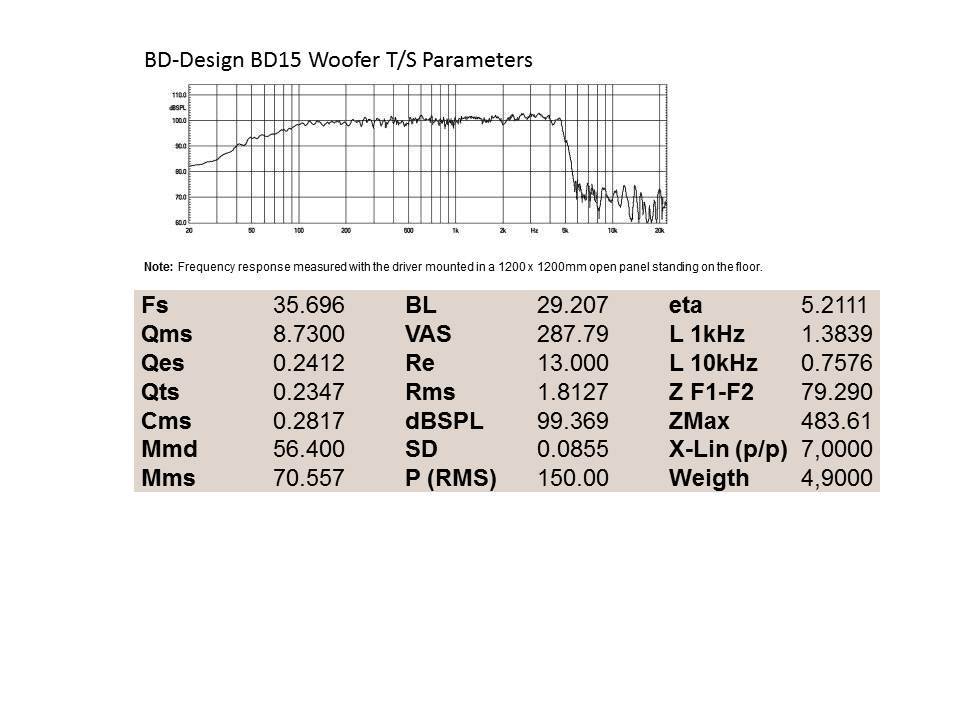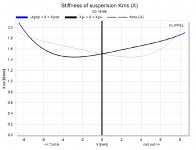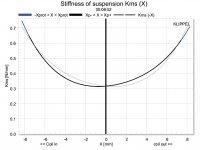I may be missing something -I had the AstraZenica vaccine yesterday and it's knocked me sideways- but I'm struggling to see anything especially profound in any of this. Maybe -possibly- you might feel like using Qm as a very imperfect and approximate guideline to a desired set of characteristics, a little like EBP. Fair enough. But since it's not 'real' and just a mathematical construct derived from mass, suspension compliance and resistance at resonance I can't see how it can be elevated to anything much more significant than that. If people want to use Rms & Cms -well, maybe a different story. But as Dave alludes to, even that is assuming piston / oscillatory conditions & the assumptions break down when / if you move into TL operating modes.
Last edited:
And thus this ‘stick-slip’ occurs also in sources, cables and amps. And in your ears. But that is not the definition of stick-slip as we know it in normal dynamics. As you sure do know as well.On a macroscopic level, yes. However, it also happens on microscopic scales inside deforming materials (like in the surround or the spider of a loudspeaker driver).
...
Not quite. While it may not be called "stick-slip" in the electro-magnetic world, the phenomenon is still there. Depending on the strength of the eddy currents, the microscopic magnetic domains of the VC former get realigned. This reorganisation of the magnetic domains requires a certain threshold forcing. Below this forcing, things are in "stick" mode. Above this forcing, it's in "slip".
...
Sure, and I never said that measuring Qms or Rms is the same as measuring "stick-slip". However, pretty much all processes covered in the Qms/Rms measurement exhibit some "stick-slip" behaviour. This is why "high Qms" usually implies "lots of stick-slip".
But hey, we need some kind of Q or R, don’t we? Which ones would be best then?
..If people want to use Rms..
I've mentioned this very thing before (and even it's inadequacy, though still quite a lot better than Qms).
Kippel's Kms (X) however does the job pretty well (..if you've got that data for your driver).
Ex. 1st Revelator 6.5" mid., 2nd SB Satori 6.5" midbass.
Attachments
Well, it is also about perspectives. A car suspension with a Qms of 5 or 10 would leave us with a car that is unsteerable. Even a Qms of 3 is relatively low related to the Qes we need to have a driver behave properly. Put otherwise: most driver motors are (far) too strong to be affected by the common Qms/Rms values. It is even neglected in the efficiency calculations of the Thiele-Small wiki, while no one here would deny that an effective Rms would lower efficiency (try to bring a car suspension into oscillation and you’ll notice effective damping absorbs quite some energy). Za (acoustic impedance) plays a role too. So to me the focus on Qms rather be 10 than 5 seems rather moot.
A driver with high Qms usually expects a low Rout amplifier to provide the damping the loudspeaker lacks inherently. Usually, the Fostex FExx6 use a horn to accomplish it.
Advocates of current amplifiers point out the benefits of using a current amplifier to drive the current device that is a VC loudspeaker. There is math that backs it up. But such an amplifier provides little or no damping to the loudspeaker, so it needs to be in the loudspeaker. Ideally Qms is 0.5 to 1 if you want to use the loudspeaker for bass.
What this does is to help show off the complexity of the trade-offs that have to be made in any loudspeaker.
Trying to equate some magical quality to a single numner, Qms, grossly misunderstands the complexity of the situation.
And as we see more and more amplifiers that start approaching that boundary between voltage amps and current amps, one starts to venture into places where high Qms is a liability.
dave
Advocates of current amplifiers point out the benefits of using a current amplifier to drive the current device that is a VC loudspeaker. There is math that backs it up. But such an amplifier provides little or no damping to the loudspeaker, so it needs to be in the loudspeaker. Ideally Qms is 0.5 to 1 if you want to use the loudspeaker for bass.
What this does is to help show off the complexity of the trade-offs that have to be made in any loudspeaker.
Trying to equate some magical quality to a single numner, Qms, grossly misunderstands the complexity of the situation.
And as we see more and more amplifiers that start approaching that boundary between voltage amps and current amps, one starts to venture into places where high Qms is a liability.
dave
I wish that there would be a growing driver segment for active speakers then 😀A driver with high Qms usually expects a low Rout amplifier to provide the damping the loudspeaker lacks inherently. Usually, the Fostex FExx6 use a horn to accomplish it.
Advocates of current amplifiers point out the benefits of using a current amplifier to drive the current device that is a VC loudspeaker. There is math that backs it up. But such an amplifier provides little or no damping to the loudspeaker, so it needs to be in the loudspeaker. Ideally Qms is 0.5 to 1 if you want to use the loudspeaker for bass.
What this does is to help show off the complexity of the trade-offs that have to be made in any loudspeaker.
Trying to equate some magical quality to a single numner, Qms, grossly misunderstands the complexity of the situation.
And as we see more and more amplifiers that start approaching that boundary between voltage amps and current amps, one starts to venture into places where high Qms is a liability.
dave
That is a good editiorial Ro808. He onl deals with what happens at resonance, and it becomes fairly clear that highish Rout amplifiers can handle things fine in the bass. His example table shows that as far as bass goes we get an effective increase in Box Q. With a sealed box it is easy to fix this by using a bigger box.
An good example is this set of simple boxes that Scott designed and illustrate what should happen to the box as Rout rises. These examples would fall into Pierces table near the end (amps like ACA, VFET, most SETs/SEPs).
http://wodendesign.com/downloads/King-of-Swingers.pdf
dave
An good example is this set of simple boxes that Scott designed and illustrate what should happen to the box as Rout rises. These examples would fall into Pierces table near the end (amps like ACA, VFET, most SETs/SEPs).
http://wodendesign.com/downloads/King-of-Swingers.pdf
dave
We are seeing more active systems as amplifiers become smaller & cheaper and people move towards “convenience”. The largest growth in this segment is, at the moment, in the low-end, bluetooth speakers (since mostly 1-way powered and active by default).
We are also seeing pro Audio stuff seeping into the hifi worls with designs such as Dutch+Dutch, Grimm, Kii, and trickling into the lower end, ELAC, Dali, and the active KEF LS50 for instance.
I have been playing with active XOs since the 70s, first the Pioneer XO, dB Systems and then cobbling things togther myself. I am a big fan of PLLXO (cheap, no electronic haze, but speaker specifically needs to be designed within their limitations).
dave
We are also seeing pro Audio stuff seeping into the hifi worls with designs such as Dutch+Dutch, Grimm, Kii, and trickling into the lower end, ELAC, Dali, and the active KEF LS50 for instance.
I have been playing with active XOs since the 70s, first the Pioneer XO, dB Systems and then cobbling things togther myself. I am a big fan of PLLXO (cheap, no electronic haze, but speaker specifically needs to be designed within their limitations).
dave
Did someone mention that the voice coil resistance is somewhat of a thingy when assessing damping factor?😀Damping Factor.
It is clearly stated in Pierce’s piece as the important missing piece in mmany discussions and not the first time i have seen the same math.
dave
dave
Did someone mention that the voice coil resistance is somewhat of a thingy when assessing damping factor?😀
Has anyone considered the material of the voice coil former as a factor?
While searching for PLLXOs I came across the website of the man who designed my cabs, that originally housed his 15" mid woofers, the parameters of which are (still) very desirable imo.


That response “with a panel 1200x1200mm standing on the floor”? Hmmm, I’d like to know the measuring protocol.
The drivers were custom designed and made by Beyma and it seems plausible the response was measured in their chamber.
Admittedly, the impedance is not as clean as the response would suggest, but it lives up to its design goal of wide band driver.
Jeff Poth compared it to the JBL 2226 and Eminence 15HO. Qms of the 3 drivers is similar in the test cab.
Admittedly, the impedance is not as clean as the response would suggest, but it lives up to its design goal of wide band driver.
Jeff Poth compared it to the JBL 2226 and Eminence 15HO. Qms of the 3 drivers is similar in the test cab.
Last edited:
Except that Qms references mechanical damping at its fundamental resonance.
Drivers primarily rely on mechanical damping below their fundamental resonance.
Because of this, low Qms drivers typically have better non-linear results near resonance. (..though often these very same drivers don't pay enough attention to distortion from inductance - and so: often have a rising harmonic distortion profile as freq.s go higher.)
Seas does this a LOT with their drivers, though they are starting to "ease-up" on this with their newer models.
The fact that Qms is by definition measured at resonance does not take away from the fact that the underlying cause - friction - is at work as soon as the cone moves. Regardless of frequency.
I looked up the factory Qms of my favorite drivers.
1.930/2.245/2.301/2.215/2.35/1.78/1.44/3.07/3.298/2.2
dave
This single measurement would have disqualified all these drivers for my further use. MarkAudio metal drivers are sort of ok when not played loud, Fostex is a taste I don't share. Both brands hold dots well but are far from sota.
While searching for PLLXOs I came across the website of the man who designed my cabs, that originally housed his 15" mid woofers, the parameters of which are (still) very desirable imo.
Impossible FR measurement, there must have been electronic manipulation.
MarkAudio metal drivers are sort of ok when not played loud, Fostex is a taste I don't share. Both brands hold dots well but are far from sota.
Yes, all those drivers are Mark Audio except for 1 Fostex and one CSS.
I have heard few of the exotics, of the ones i have none bettered the best Alpairs, but i expect they are out there. They can certainly play loud if used with helper woofers. Trying to play loud with any 1-way speaker is ussually problematic in some way.
dave
- Home
- Loudspeakers
- Multi-Way
- The significance of high Qms..?

